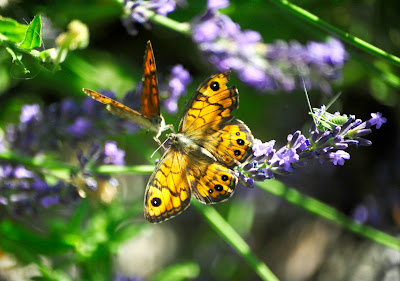
Are you tired of spending every weekend mowing your lawn? Join millions of Americans who are ditching the traditional grass yard for something more exciting: wildflower meadow gardening. This growing trend combines beautiful, natural-looking landscapes with minimal maintenance, creating spaces that support local wildlife while saving you time and money. Whether you have a small suburban lot or acres of land, wildflower meadows offer a sustainable alternative that's taking the gardening world by storm.
The Wildflower Revolution Sweeping America
Wildflower meadow gardening represents a major
shift in how Americans think about their outdoor spaces. Instead of fighting
nature with weekly mowing, fertilizing, and watering, meadow gardens work with
natural processes to create beautiful, self-sustaining landscapes.
This trend has exploded on social media platforms, with
"chaos gardening" videos on TikTok receiving millions of views. The
concept is simple: plant a diverse mix of native wildflowers and grasses, then
let nature take the lead. The results are stunning displays of color that
change throughout the seasons.
The environmental benefits are impressive too. Native
wildflower meadows support local pollinators like bees and butterflies, many of
which are struggling due to habitat loss. A single acre of diverse wildflower
meadow can support over 1,000 different insect species, compared to just a
handful in a typical lawn.
Why Americans Are Choosing Wildflower Meadows
Cost savings drive many homeowners to consider meadow
gardening. The average American family spends $503 annually on lawn care,
including mowing, fertilizers, and water bills. Established wildflower meadows
require minimal inputs after the first year, potentially saving hundreds of
dollars annually.
Time savings are equally compelling. Traditional lawns need
weekly mowing during growing season—that's 30-40 hours per year for an average
yard. Wildflower meadows typically need cutting just once annually, freeing up
weekends for more enjoyable activities.
Water conservation has become increasingly
important as drought conditions affect large portions of the United States.
Native wildflowers adapt to local rainfall patterns, requiring minimal
irrigation once established. This contrasts sharply with traditional lawns, which
can require up to 1 inch of water weekly during summer months.
Planning Your Wildflower Meadow

Soil testing isn't always necessary for wildflower meadows.
Unlike vegetable gardens that need rich, fertile soil, many wildflowers
actually perform better in average to poor soils. Rich soil can favor
aggressive grasses over desirable wildflowers, so don't add compost or
fertilizer unless soil tests show severe deficiencies.
Size doesn't matter—start small and expand gradually.
Even a 10x10 foot area can create a stunning wildflower display. Many
successful meadow gardeners begin by replacing a section of their front yard,
then expand as they gain confidence and see results.
Selecting the Right Wildflower Mix
Regional adaptation is crucial for success. Seeds
marketed as "wildflower mix" often contain non-native species that
may not survive local conditions or could become invasive. Research native
plants in your specific region—what thrives in Texas differs significantly from
what works in Minnesota.
Contact your local extension office or native plant society
for recommendations. Many states offer pre-mixed native wildflower seeds
appropriate for different regions and soil types. These mixes typically include
both annual flowers for quick color and perennial species for long-term
stability.
Popular native wildflowers for different regions include:
- Northeast:
New England aster, black-eyed Susan, wild bergamot
- Southeast:
purple coneflower, blanket flower, wild indigo
- Midwest:
prairie dropseed, little bluestem, wild lupine
- Southwest:
desert marigold, penstemon, Mexican hat
- West
Coast: California poppy, farewell-to-spring, blue-eyed grass
Planting and Establishment
The "scatter and pray" method works
surprisingly well for wildflower seeding. Mix small seeds with sand to
ensure even distribution, then broadcast across the prepared area. Light raking
after seeding ensures good soil contact without burying seeds too deeply.
Water management during establishment is critical.
Keep soil consistently moist but not waterlogged for the first 6-8 weeks. Once
plants establish, gradually reduce watering to encourage deep root development.
Most native wildflowers become drought-tolerant after the first growing season.
Maintenance and Long-Term Care
Patience is essential during the establishment year.
Many wildflower meadows look sparse the first season as perennial plants focus
energy on root development rather than flowers. Annual flowers provide color
while slower perennials get established.
Weed management requires selective intervention.
Hand-pull obvious weeds like dandelions or crabgrass, but learn to identify
native plants in their juvenile stages to avoid removing desired species.
Annual maintenance keeps meadows healthy and attractive.
Most wildflower meadows benefit from yearly cutting to prevent woody plant
invasion and maintain species diversity. Cut in late fall to allow seeds to
mature and provide winter habitat, or cut in early spring before new growth
begins.

Enjoying Your Wildflower Meadow
Wildflower meadows provide year-round interest beyond
just summer blooms. Spring brings fresh green growth and early flowers.
Summer offers peak color and pollinator activity. Fall displays seed heads and
changing foliage colors.
Create pathways through larger meadows to allow close
observation of plants and wildlife. Simple mowed paths or stepping stone trails
let you explore without disturbing the natural character.
Document your meadow's changes with photos throughout the
seasons. This helps you learn which plants thrive in your conditions and
provides content for social media if you're sharing your gardening journey
online.
Wildflower meadow gardening offers a sustainable, beautiful
alternative to traditional landscaping that benefits both homeowners and the
environment. By working with nature instead of against it, you can create
outdoor spaces that require less maintenance while providing more ecological
value. Whether you start with a small corner of your yard or transform your
entire landscape, wildflower meadows represent the future of American
gardening.
Ready to start your wildflower meadow? Begin small with a
test area to gain confidence, then expand as you see results. Your future
self—and local wildlife—will thank you for taking this step toward more
sustainable, beautiful landscaping.

Comments
Post a Comment